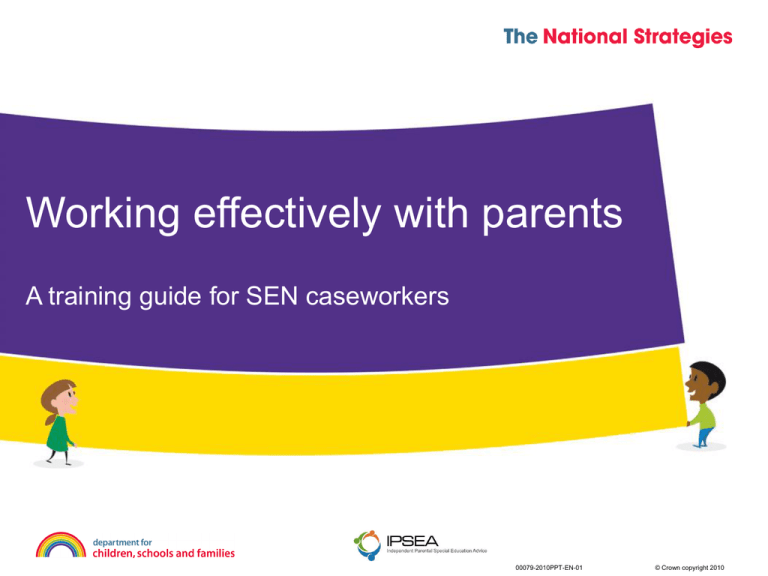- WhatDoTheyKnow
advertisement

Working effectively with parents A training guide for SEN caseworkers 00079-2010PPT-EN-01 © Crown copyright 2010 Introduction and Background 2 00079-2010PPT-EN-01 © Crown copyright 2010 A Parental Perspective 3 00079-2010PPT-EN-01 © Crown copyright 2010 Aims of the training • To understand the importance of working in partnership with parents • To reflect on parents’ experiences of the special educational needs (SEN) system • To consider how SEN caseworkers can improve parents’ confidence • To develop skills in communicating effectively with parents • To highlight key areas of legislation and parents’ rights 4 00079-2010PPT-EN-01 © Crown copyright 2010 Background – The Lamb Inquiry, 2009 Video clip 1: Introduction, Brian Lamb Key recommendations for change: • Higher expectations and greater focus on outcomes for children with SEN • Better ways of engaging and listening to parents • Improving expertise in identifying and meeting needs • A more accountable system for schools and local authorities (LAs) for SEN 5 00079-2010PPT-EN-01 © Crown copyright 2010 From: The Lamb Inquiry Final Report, 2009 ‘We met with some of the happiest parents in the country and some of the angriest. Many had children who are well-supported and making good progress. But we also met parents for whom the education system represents a battle to get the needs of their children identified and for these to be met. The crucial issue is that both experiences happen within the same system.’ Video clip 2: My child Video clip 3: Influences on parental confidence 6 00079-2010PPT-EN-01 © Crown copyright 2010 Parents say their confidence in the SEN system is… ... undermined by poor communication and lack of accurate information, for example: • what they say is not being given weight • SEN caseworkers being hard to reach or not communicating about decisions • parents being given information which reflects LA policy rather than the law • lack of transparency in how decisions are made • inconsistencies in information 7 00079-2010PPT-EN-01 © Crown copyright 2010 Parents say their confidence in the SEN system is... ... promoted by successful communication and accurate, clear information, for example: • their child being valued as an individual • responsiveness to immediate issues around their child’s education • acknowledgement of the wider family context • having confidence in the accuracy of information • clear, accessible guidance on their legal rights • knowledgeable front-line professionals 8 00079-2010PPT-EN-01 © Crown copyright 2010 Session 1 Communicating effectively with Parents Video clip 4: Aspirations 9 00079-2010PPT-EN-01 © Crown copyright 2010 Key point Parents want to work with professionals who listen to their aspirations for their child and understand their family context Video clip 5: Understanding the family context 10 00079-2010PPT-EN-01 © Crown copyright 2010 Key point Parents want accurate, timely and clear information 11 00079-2010PPT-EN-01 © Crown copyright 2010 Remember... • Good information can help parents know what to expect, make decisions and promote their confidence but information on its own can confuse and overload parents • Parents also want to feel involved, have the chance to ask questions and raise concerns, have face to face contact and – at times – help to process information Video clip 6: Sharing information 12 00079-2010PPT-EN-01 © Crown copyright 2010 The importance of listening skills Basic active listening skills can make a big difference to establishing trust and partnership: • showing you are listening through body language • waiting and not jumping in too quickly • repeating and paraphrasing • clarifying by using questions • summarising and ending But remember – you are not holding a counselling session! Video clip 7: Listening to parents 13 00079-2010PPT-EN-01 © Crown copyright 2010 Structured conversations The aim of this approach is to have a listening conversation, which draws on parents’ knowledge and aspirations for their child. A structured conversation aims to: • explore, understand and clarify issues • help identify priorities and desired outcomes • agree next steps and actions When could SEN caseworkers use this approach in their work with parents? 14 00079-2010PPT-EN-01 © Crown copyright 2010 Effective meetings • Prepare well (e.g. agree the agenda and stick to it) • Check practical issues (e.g. timing, venue) • Deal with conflict (e.g. listen, speak calmly, clarify any complaints) • Use problem solving (e.g. break down the problem, identify a range of possible solutions, plan who will do what) • Summarise and agree next steps • Provide a written summary Video clip 8: Meeting parents 15 00079-2010PPT-EN-01 © Crown copyright 2010 Communicating with parents – key points • Be clear what decisions you as SEN caseworker can make and those you do not have power to make • Keep a record of information you have given to parents • Make sure you maintain regular contact with parents • Tailor information to meet individual parents’ needs • Ensure parents have a clear written record of anything you have told them or explained 16 00079-2010PPT-EN-01 © Crown copyright 2010 In pairs consider what have been your key personal learning points from the day 17 00079-2010PPT-EN-01 © Crown copyright 2010 Session 2 Building parental confidence in the SEN system 18 00079-2010PPT-EN-01 © Crown copyright 2010 The SEN framework • LAs need to understand what the law requires them to do and fulfil those requirements • LAs need to ensure that all staff working in any particular area of activity understand and fulfil the legal requirements relevant to that area of activity 19 00079-2010PPT-EN-01 © Crown copyright 2010 Partnership working with parents • This is a long-established feature of the SEN framework • For most parents partnership working is with the school as the majority of children will have their needs met there • How the school engages with parents at these early stages underpins parental confidence in the whole SEN system • SEN caseworkers should be familiar with the legal duties of schools and governors in relation to SEN • They should also know what should be included in individual education plans (IEPs) or alternative approaches 20 00079-2010PPT-EN-01 © Crown copyright 2010 The statutory assessment process Key things SEN caseworkers need to know: • • • • The law on identifying and assessing children The law on making statements and carrying out reviews LA duties and parents’ rights The advice and information that needs to be given to parents • The statutory assessment timetable • The framework for tribunal appeals 21 00079-2010PPT-EN-01 © Crown copyright 2010 Special Educational Needs (a) Meaning of “special educational needs” (EA 1996 s. 312) • A child has “SEN” if he has a learning difficulty which calls for special educational provision to be made for him. (b) Meaning of “learning difficulty” (EA 1996 s. 321) • Child has a significantly greater difficulty in learning than the majority of children of his age • Child has a disability which either prevents or hinders him from making use of educational facilities of a kind generally provided for children of his age in the LEA’s schools, or • Child is under compulsory school age and is, or would be if special educational provision were not made for him, likely to fall within the above definitions. 22 00079-2010PPT-EN-01 © Crown copyright 2010 Statutory Assessment – key legal issues EA 1996 s. 323 (1) & (2) Where the LEA is of the opinion that a child for whom it is responsible has or probably has SEN and it is necessary for the authority to determine the special educational provision which any learning difficulty he may have calls for, the LEA must carry out a statutory assessment EA 1996 s. 324 Following a statutory assessment and any representations made by the child’s parent, if it is necessary for the LEA to determine the special educational provision which any learning difficulty he may have calls for, the authority shall make and maintain a statement of his SEN. 23 00079-2010PPT-EN-01 © Crown copyright 2010 The statutory assessment process • Relationships with parents can flourish or flounder depending on how the process is managed • A statutory assessment may be the start of a long-term relationship between the SEN caseworker and the family • The SEN caseworker plays a key role in getting the communication with parents right 24 00079-2010PPT-EN-01 © Crown copyright 2010 Potential tension points • Responding to requests for statutory assessment • Decisions about issuing statements • The content of statements and deciding placements • Annual reviews and amending statements • Appeals Video clip 9: Parental experience of the SEN system 25 00079-2010PPT-EN-01 © Crown copyright 2010 Building trust Parents say they lose trust because of: • inconsistent messages (e.g. whether statutory assessment is necessary) • conflicting reasons given for decisions • advice based on LA policy rather than the law • professional reports appearing to be tailored to available provision rather than their child 26 00079-2010PPT-EN-01 © Crown copyright 2010 Building trust Some parents feel they are given misleading reasons for decisions: • • • • ‘Children’s needs must be severe and complex...’ ‘A child must be among the 2% worst performing...’ ‘We don’t give statements for dyslexia in this authority…’ ‘There are children “far worse” than your child that don’t have statements …’ • ‘We no longer statement children because all needs are met in mainstream schools.’ 27 00079-2010PPT-EN-01 © Crown copyright 2010 Building trust Even when there are disagreements, trust can be maintained if you: • are open about parents’ rights • are clear about LA responsibilities • listen and draw on parents’ views/ knowledge when making decisions • use straightforward language to explain things • engage with parents as soon as possible after receiving a request for assessment • focus on progress and outcomes 28 00079-2010PPT-EN-01 © Crown copyright 2010 Decision making Parents’ confidence in the LA’s decision is promoted when: • decision making and panel processes are transparent • honest reasons are given for the decision • the LA is proactive in communicating with parents and involves the school • communication is face to face • there is clear, consistent information about the school’s provision for the child and funding and resources • the LA’s letters to parents comply with the legal requirements and are personalised • parents are informed of their rights to challenge the decision 29 00079-2010PPT-EN-01 © Crown copyright 2010 The views of parents and children Statements need to include the views of parents and the child. Personal contact over this can provide the SEN caseworker and parent the opportunity to develop a shared understanding of the child. Check... • Do the parents have impairments? • Will they need information translated/in a different format? • How will the child’s view be given? 30 00079-2010PPT-EN-01 © Crown copyright 2010 Statements: What parents dislike... • • • • • Jargon or language which is unclear Cut-and-paste standard phrases Getting their child’s name wrong Vague and non-specific description of provision Gaps in needs or provision Note – statements must “specify the special educational provision to be made for the purpose of meeting those needs” (EA 1996 s. 324 (3)(b)) Video clip 10: Statements 31 00079-2010PPT-EN-01 © Crown copyright 2010 Good statements... • • • • • • • are written in clear and understandable language are personalised are accurate include parents and children’s views ensure objectives relate to provision specify provision clearly allow progress to be monitored over time 32 00079-2010PPT-EN-01 © Crown copyright 2010 Meetings about the statement This is another crucial point in the process. ‘Every effort should be made to ensure that parents are happy with the proposed statement and that they understand the background to the proposals made for their child and consider that their wishes and feelings have been given full and sensitive consideration.’ (CoP, 8.106) 33 00079-2010PPT-EN-01 © Crown copyright 2010 Placements and the law 1 EA 1996 schedule 27 (3)(3) Where the parent of the child concerned has expressed a preference in pursuance of such arrangements as to the school at which he wishes education to be provided for his child, LEA shall specify the name of that school in the statement unless – (a) the school is unsuitable to the child’s age, ability or aptitude or to his SEN, or (b) the attendance of the child at the school would be incompatible with the provision of efficient education for the children with whom he would be educated or the efficient use of resources. 2 EA 1996 s. 316 (3) If a statement is maintained for a child, he must be educated in a mainstream school unless that is incompatible with – (a) the wishes of his parent, or (b) the provision of efficient education for other children. 3 EA 1996 s.9 Pupils are to be educated in accordance with the wishes of their parents, so far as that is compatible with the provision of efficient instruction and training and the avoidance of unreasonable public expenditure. 34 00079-2010PPT-EN-01 © Crown copyright 2010 Placements SEN caseworkers can help parents with decisions about placement by: • • • • • explaining the law informing them about school SEN policies helping parents to visit appropriate schools clarifying transport arrangements suggesting sources of other support/advice 35 00079-2010PPT-EN-01 © Crown copyright 2010 Annual reviews and the law EA 1996 s.328 (5)(b) (a) on the making of an assessment in respect of the child concerned under section 323, and (b) in any event, within the period of 12 months beginning with the making of the statement or, as the case may be, with the previous review. 36 00079-2010PPT-EN-01 © Crown copyright 2010 Annual reviews Don’t … • ignore recommendations for changes or updates • accept continued repeats of existing targets if progress has not been made • think only short term: the review is intended for long-term planning too • make blanket cuts to provision on statements 37 00079-2010PPT-EN-01 © Crown copyright 2010 Annual reviews Do... • • • • offer to help parents prepare for the review provide good information, particularly at transitions contact parents even if the decision is ‘no action’ arrange for an interim review if there is disagreement or concern about progress • meet with parents to explain reasons for changes to provision or a decision to cease the statement • know and meet the timescales and legal requirements 38 00079-2010PPT-EN-01 © Crown copyright 2010 Appeals to tribunal SEN caseworkers need to know: • the tribunal framework • parents’ rights of appeal In the event of an appeal SEN caseworkers need to: • maintain a professional approach • continue to listen to parents and keep the lines of communication open • understand the parents’ perspective and the potential impact of the tribunal process on the family Video clip 11: Tribunal experience 39 00079-2010PPT-EN-01 © Crown copyright 2010 And finally……top tips Video clip 12: Top tips • • • • • • • • • • Ask parents to talk about their aspirations for their child Remember that parents are the experts on their child Be clear, accurate and open Stick to the law Be an active and empathic listener Be approachable and accessible Seek out the child’s views Personalise written communication Keep communication channels open – even if you disagree Signpost parents to further information and sources of independent advice 40 00079-2010PPT-EN-01 © Crown copyright 2010 Final Reflections 41 00079-2010PPT-EN-01 © Crown copyright 2010 Crown copyright • • The content of this publication may be reproduced for non-commercial research, education or training purposes provided that the material is acknowledged as Crown copyright, the publication title is specified, it is reproduced accurately and not used in a misleading context. For any other use of this material please apply to OPSI for a Click-Use, PSI Licence, or by writing to: Office of Public Sector Information Information Policy Team National Archives Kew Richmond Surrey TW9 4DU Email: xxxxxxxxx@xxxx.xxx.xx Web: www.opsi.gov.uk/click-use/index.htm • The permission to reproduce Crown copyright protected material does not extend to any material in this publication which is identified as being the copyright of a third party, or to Royal Arms and other departmental or agency logos, nor does it include the right to copy any photographic or moving images of children or adults in a way that removes the image or footage from its original context. 42 00079-2010PPT-EN-01 © Crown copyright 2010






